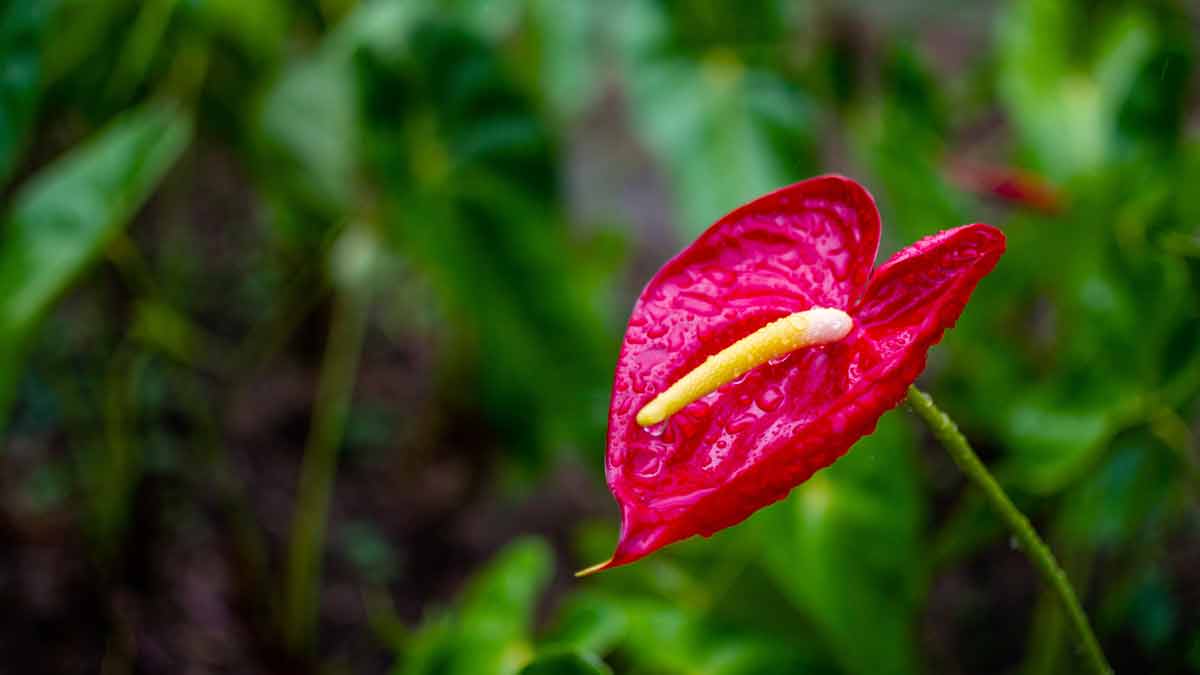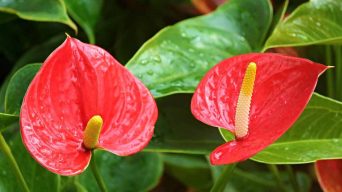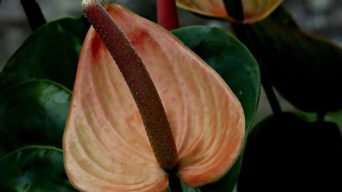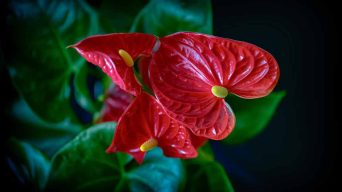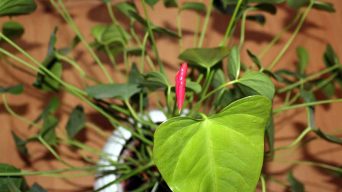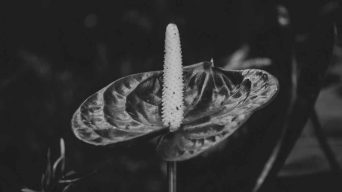Anthuriums with wilting, yellowing, or browning leaves may be overwatered, leading to poor aeration, root rot, and improper water absorption. To save an overwatered Anthurium, gently remove it from the container, remove excess soil around the roots, allow it to dry completely, and repot in fresh, well-draining soil.
Anthurium plants, known for their vibrant and stunningly beautiful flowers, can quickly become a victim of overwatering.
As plant enthusiasts, it is essential to understand the causes and symptoms of an overwatered Anthurium and the best solutions to ensure your plant thrives in optimal health.
Here we’ll delve into how you can identify and tackle overwatering issues so that your Anthurium remains lush and vibrant.
Importance Of Proper Watering For Anthurium
To ensure the healthy growth and development of Anthurium plants, it is essential to understand the significance of proper watering.
These plants thrive in moist soil, but overwatering can lead to waterlogging and negatively impact their growth.
Thus, striking the right balance between providing enough water and avoiding excess moisture is crucial for maintaining the health of Anthurium plants.
How Much Water Does An Anthurium Need?
Anthurium plants thrive with just the right amount of water, which is crucial in maintaining their vibrant appearance and robust growth.
Generally, these tropical plants require watering once a week during the warmer growing season.
However, it’s essential to remember that different Anthurium species may have slightly varying water requirements.
To determine whether your Anthurium needs watering, check if the upper portion of the soil has dried out.
You can do this by gently poking your finger about an inch into the potting mix or using a moisture meter for more accurate results.
If you notice that the top layer of soil is dry but moist underneath, it’s time to give your plant some hydration!
Be sure not to overwater; providing only enough liquid so that it reaches down to its roots will keep both foliage and flowers looking fresh and healthy.
Misting your Anthurium with lukewarm water can also help maintain optimal humidity levels without inviting root rot caused by excess moisture in its potting environment.
How Often Should Anthurium Be Watered?
Determining the ideal watering frequency for anthurium plants is essential in maintaining their overall health and well-being.
Generally, these tropical beauties require a consistent watering schedule, with most varieties needing water once a week during the warmer growing season.
However, adjusting the frequency based on factors such as temperature, humidity levels, and specific plant needs is crucial.
For instance, an overwatered Anthurium may show yellowing leaves or signs of root rot due to excessive moisture in the soil.
In cases like this, reduce your watering schedule and ensure proper soil drainage to avoid further damage.
On the other hand, if your space has low humidity or if your Anthurium is exposed to direct sunlight for extended periods like flamingo flowers and queen anthuriums often prefer; you might need to slightly increase your watering routine while ensuring that excess water can drain effectively from its potting mix.
Always remember that every indoor plant has unique requirements; monitor your individual Anthurium’s condition closely to provide optimal care for healthy growth throughout each season.
Consequences Of Overwatering An Anthurium
Overwatering an Anthurium plant can lead to many problems, impacting your beloved tropical plant’s overall health and appearance.
One major consequence is root rot, which occurs when the roots are consistently submerged in waterlogged soil.
This compromises the Anthurium’s structural integrity and inhibits its ability to absorb essential nutrients and water properly.
In addition to root rot, overwatered Anthurium plants may experience yellowing or browning leaves due to reduced chlorophyll production.
Consequently, this affects photosynthesis and energy production within the plant.
Over time, these issues could lead to sluggish growth and even loss of flowers – turning your once vibrant Flamingo Flower into a sad sight for sore eyes!
Moreover, excessive moisture creates an ideal environment for fungal infections such as anthracnose and bacterial leaf spot diseases that further damage your treasured indoor plant.
By preventing overwatering and promoting proper care routines, you can ensure that your Anthurium remains healthy and thriving year-round.
Causes Of Overwatered Anthurium
Overwatering is a common issue that can affect the health and growth of Anthurium plants.
Various factors, such as watering practices, soil quality, pot type and size, drainage problems, and environmental conditions like high humidity and temperature, can cause this problem.
Understanding the causes of overwatered Anthurium is essential to prevent this issue and maintain healthy plant growth.
Below, we’ll explore these factors in more detail to help you identify and avoid overwatering your Anthurium.
Watering Frequency And Amount
Proper watering is essential for the healthy growth of anthurium plants. Generally, Anthuriums need to be watered once every 1-2 weeks, but this can vary depending on different factors such as humidity and temperature.
To determine if your Anthurium needs watering, you can feel the top inch or two of soil. If it feels dry, it’s time to water your plant.
It’s important not to let your potting mix become completely dry as well because underwatering can also lead to drooping leaves in anthurium plants.
When watering your Anthurium, ensure you’re using a pot with good drainage holes, and remember that smaller pots will require more frequent watering than larger ones.
Additionally, be mindful of the amount of water you give your plant each time – avoid pouring too much water at once so that the roots don’t get flooded.
Remember: proper watering frequency and amount are crucial for preventing overwatering and underwatering issues in Anthurium plants.
Soil Type And Quality
Soil type and quality play a crucial role in the health of Anthurium plants.
Anthuriums prefer well-draining soil that allows water to run through it quickly, preventing waterlogging.
A good potting mix should contain elements such as perlite or bark, as they help with better drainage.
Another option is adding orchid bark or sphagnum moss to help create an optimal growing medium for your Anthurium plant.
Poor soil quality can also prevent proper nutrient absorption leading to stunted growth and yellowing leaves on your plant.
Therefore, choosing the right kind of soil is critical when repotting Anthurium plants.
A high-quality peat-based mixture enriched with a balanced fertilizer will keep your Anthurium healthy and vibrant throughout its growing season. Remember that overfertilization can be damaging too, so always follow instructions when fertilizing and avoid giving excessive amounts beyond what your plant needs!
Pot Type And Size
The type and size of the pot you use to grow your Anthurium plant can be a factor in causing overwatering.
A pot that is too large holds more water than the plant needs, while a small pot won’t have enough space for roots to grow.
Choosing a well-draining pot with drain holes at the bottom is essential to prevent water from accumulating in the soil.
For smaller Anthurium species like Anthurium crystallinum or flamingo flower, opt for pots no more than two inches wider than their current containers.
For larger species like queen Anthurium or Anthurium andreanum, choose pots slightly bigger than their root ball (around 1-2 inches).
Moreover, consider using terracotta pots as they help absorb excess moisture and promote better airflow around the roots.
By selecting an appropriately sized pot with proper drainage, you’re not only preventing overwatering but also giving your plants room to develop healthy roots and thrive.
Drainage Issues
Poor drainage is a common cause of overwatered Anthuriums.
When the soil doesn’t drain well, it becomes waterlogged and can lead to root rot, which is detrimental to the plant’s health.
This problem can be caused by several factors, such as inadequate drainage holes in the pot or using heavy soil types that do not aerate properly.
To ensure good drainage for your Anthurium, use a container with at least one drainage hole at the bottom and fill it with light, well-draining soil mixtures such as orchid bark or sphagnum moss combined with regular potting mix.
These materials allow excess water to pass through quickly while retaining enough moisture for the roots to absorb nutrients.
Remember to avoid compacting the soil when planting and repotting your Anthurium. This also affects proper airflow within its root system, causing poor draining, ultimately leading to overwatering issues.
High Humidity And Temperature
High humidity and temperature can lead to overwatering in Anthurium plants.
This is because the excess moisture in the air slows down evaporation, making it difficult for the soil to dry out properly between watering sessions.
As a result, the roots may become waterlogged, suffocating, and deteriorating over time.
To prevent this issue, monitoring your Anthurium environment closely by monitoring the temperature and humidity levels is essential.
One way to control humidity levels is by using a dehumidifier or placing a tray of pebbles filled with water beneath your plant pot.
This helps create a more balanced environment for your Anthurium plant while avoiding excess moisture buildup that could cause damage.
Additionally, consider moving your Anthurium away from areas with high humidity, like bathrooms or laundry rooms, into well-ventilated spaces with adequate air circulation.
If you notice signs of overwatering, such as yellowing leaves or root rot due to high humidity levels, it’s essential to act quickly before further damage occurs.
Symptoms Of Overwatered Anthurium
When caring for Anthurium plants, it’s important to strike a balance with watering.
Overwatering can lead to various symptoms, including wilting, yellowing, and browning of leaves, as well as fungal and bacterial infections.
If your Anthurium exhibits sluggish growth or root rot, it may be a sign of overwatering.
Recognizing these symptoms early on can help you adjust your watering schedule and avoid further damage to the plant.
Sluggish Growth
Sluggish growth is one of the most noticeable symptoms of overwatering in Anthurium plants.
When an Anthurium gets too much water, its roots become saturated and cannot absorb oxygen effectively.
This leads to a decline in the plant’s overall health, resulting in slower growth and less vigorous foliage.
The leaves may also turn yellow or brown at the tips or edges due to nutrient deficiencies caused by poor root function.
To prevent sluggish growth due to overwatering, ensuring that your Anthurium has access to well-aerated soil with good drainage is important.
Wilting
Wilting is a common symptom of overwatering in Anthurium plants.
The excess moisture can cause the roots to rot and prevent them from absorbing oxygen properly, leading to a decrease in water uptake by the plant.
As a result, the leaves start to droop and wilt due to lack of hydration.
This can be easily detected by feeling the soil for dampness or checking if there is standing water in the pot’s drainage tray.
Yellowing Or Browning Leaves
Yellowing or browning leaves are common problems that Anthurium growers face.
These discolorations can be caused by overwatering, lack of nutrition, humidity issues, or inconsistent watering habits.
Overwatering is one of the leading causes of yellowing and browning in Anthurium plants.
When an Anthurium plant receives too much water, it may experience root rot, leading to roots breaking down and a limited ability to absorb nutrients.
If you notice yellow or brown spots on your Anthurium leaves, it could indicate that your plant suffers from a fungal infection requiring specific remedies.
Brown spots can also suggest a pest infestation or inconsistent watering practices, resulting in moisture buildup on the leaves.
Root Rot
Root rot is one of the most common problems caused by overwatering Anthurium plants.
This occurs when too much moisture is in the soil, leading to a lack of oxygen around the roots.
Dark and mushy roots are a clear indication of this problem.
Fungal And Bacterial Infections
Overwatering can cause fungal and bacterial infections in Anthurium plants.
When the soil is too moist, it creates a perfect environment for these diseases to thrive.
Root rot is one of the most common problems caused by overwatering anthuriums, and it’s often a sign of a dying plant.
The roots become mushy and brown, causing them to die off, eventually affecting the plant’s overall health.
Another disease caused by overwatering is bacterial blight, which was a significant problem in Hawaii’s Anthurium industry in the 1990s.
This highly contagious disease spreads quickly through contaminated water or tools used on infected plants.
If you suspect your plant has this disease, it’s essential to get a proper diagnosis and treatment plan as soon as possible to prevent its spread.
How To Prevent Overwatering Anthurium Plants
To prevent overwatering in Anthurium plants, it’s crucial to follow proper watering methods, choose appropriate soil and pots with sufficient drainage, and stay vigilant for signs of overwatering.
By taking these preventive measures, you can ensure your Anthurium plants stay healthy and vibrant.
Proper Watering Technique
Anthurium plants require a proper watering technique to thrive.
Here are some tips for watering your Anthurium plant:
- Use the bottom-watering method: This involves placing the plant in a container with water that is allowed to soak up through the soil from the bottom. This helps prevent overwatering and ensures that roots have access to water.
- Water only when needed: You should only water your Anthurium when the soil is dry to about 1 inch deep. Overwatering can cause root rot and other issues while underwatering can lead to wilting and browning of leaves.
- Use room temperature water: Cold water can shock the plant, and hot water can damage its roots, so it’s important to use it for Anthurium.
- Don’t let the soil become too dry: While it’s important not to overwater, you don’t want to let the soil become bone-dry, as this can also harm your plant.
- Adjust moisture levels based on humidity: In high-humidity environments, you may need to reduce watering frequency since the air already contains moisture. Conversely, indoor heating can dry out the air in dry climates or during winter, so you may need to increase watering frequency.
Choosing The Right Soil, Pot, And Drainage System
Choosing the right soil, pot, and drainage system prevents overwatering in Anthurium plants.
Here are some tips:
- Use a well-draining soil mix: Anthurium plants prefer loose and well-draining soil that allows excess water to flow out quickly. A mixture of peat moss, perlite, and orchid bark can provide good drainage.
- Pick the right pot size: Choose a pot that is not too big or too small for your Anthurium plant. Ensure it has proper drainage holes at the bottom to allow excess water to escape.
- Opt for breathable pots: Use porous pots made of terracotta or unglazed ceramic that allow air circulation and water evaporation from the sides.
- Avoid decorative pots without drainage holes: While they might look pretty, they can trap excess water and lead to root rot.
- Maintain a good drainage system: Check that the pot’s tray or saucer is empty after watering to prevent standing water from accumulating around the roots.
Checking For Signs Of Overwatering
To prevent overwatering an Anthurium plant, checking for signs of moisture stress is essential.
Yellow leaves, drooping plants, and brown spots on the leaves indicate that your Anthurium might be getting too much water.
If you notice any of these symptoms, it’s time to reassess your watering habits and examine the soil’s drainage capabilities.
Checking the soil regularly can also help identify if it is too wet or dry.
A simple test to check the moisture level is inserting a finger into the soil up to about an inch; if the topsoil feels dry, it’s time to water your plant moderately.
Another common sign of overwatered Anthurium includes root rot – a fungal disease that occurs when excessive soil moisture leads to wilting stems and yellowing leaves with blackened roots.
Root rot can spread quickly and cause significant damage within days; hence checking for this sign promptly is crucial.
It may also indicate that you need more ventilation around your plants’ growing area as high humidity levels contribute significantly to overwatering and pests’ growth, such as spider mites or thrips that can further harm a weakened plant due to excess water in its system.
How To Treat Overwatered Anthurium Plants
If you’ve overwatered your Anthurium plant and noticed signs of stress or root rot, don’t worry!
There are steps you can take to help it recover.
Firstly, gently remove the plant from its container, examine the roots for damage, and remove any affected ones.
Then, repot the plant in a well-draining potting mix and water it appropriately, keeping a close eye on it.
This guide will help you treat your overwatered Anthurium plant and restore its health.
Gently Remove The Entire Plant From Its Container
If your Anthurium shows signs of overwatering, such as wilting, yellowing leaves, or root rot, it’s time to take action to save the plant.
One essential step is gently removing the entire plant from its container.
Here’s what you should do:
- Prepare the workspace: Lay down a newspaper or towel on a flat surface and gather all the necessary tools, including pruning shears, a clean container with drainage holes, and fresh potting mix.
- Carefully lift the Anthurium out of its current container: Gently turn the pot over while supporting the base of the plant with one hand. If necessary, tap or loosen the sides of the pot until the root ball is released.
- Inspect for root damage: Look for any signs of unhealthy roots, such as black or mushy areas, which indicate root rot caused by overwatering.
- Remove any damaged roots: Cut away any dark or soft roots at their base using sterilized scissors or pruning shears.
- Repot in fresh soil: Fill your new pot with fresh soil mixture and create a small hole in its center to support your anthurium plant in place. Place your Anthurium onto this hole and cover its roots with fresh soil.
- Water thoroughly but sparingly: After repotting your Anthurium into fresh soil mix, water it well. Be mindful not to overwater it again; wait until excess water drains out before putting it back in place.
Remove As Much Of The Soil From Around The Roots As Possible
When treating an overwatered Anthurium plant, removing as much of the soil from around the roots as possible is crucial. Here’s a simple guide on how to do it:
- Carefully remove the plant from its pot and gently loosen the soil around the roots.
- Using your fingers or a small brush, gently remove as much of the soil as possible without damaging the roots.
- Scrutinize the roots for root rot or any signs of damage. Trim off any brown, mushy, or slimy parts with a sterile pair of scissors.
- After removing unhealthy roots, soak the remaining healthy ones in a fungicide solution.
- Allow them to air dry for an hour before repotting in a fresh, well-draining potting mix.
Check For Root Rot And Remove Affected Roots
It’s essential to check for root rot if you suspect your Anthurium is overwatered.
Root rot can cause yellowing foliage, stunted growth, and plant wilting.
Here’s how to check for and treat root rot in an overwatered Anthurium:
- Gently remove the entire plant from its container.
- Remove as much of the soil from around the roots as possible.
- Check for black or mushy roots – these are signs of root rot.
- Using clean, sharp scissors or shears, remove any affected roots by cutting them off with a clean cut close to the base of the plant.
- Repot the Anthurium in a well-draining potting mix, such as one with orchid bark and sphagnum moss.
- Water the plant properly and monitor it closely.
Repot The Anthurium In A Well-draining Potting Mix
When repotting an overwatered Anthurium plant, one of the most important steps is to choose a potting mix that promotes good drainage.
Here’s how to do it:
- Choose a well-draining potting mix formulated explicitly for epiphytes like Anthurium plants.
- Include orchid bark, perlite, or sphagnum moss to improve aeration and drainage.
- Avoid using heavy or compact soil mixes that can retain moisture and lead to root rot.
- Ensure that the new pot has drainage holes to prevent water from pooling at the bottom of the pot.
- Repot the Anthurium in a slightly larger pot than its current size, ensuring enough room for roots to grow without waterlogging.
- Add fresh potting mix around the roots and gently pat it down, making sure not to compact it too much.
- Water the Anthurium thoroughly but avoid saturating the soil.
Remember to monitor your plant closely afterward and adjust watering habits as needed to prevent further issues.
Water The Plant Properly And Monitor It Closely
Watering an Anthurium plant properly and monitoring it closely is crucial to keep it healthy.
Here are some tips on how to do it:
- Water the plant only when the top 1-2 inches of soil feel dry.
- Use room temperature water and water thoroughly, ensuring excess water drains out of the pot’s bottom.
- Avoid letting the plant sit in standing water, leading to root rot.
- Monitor the plant for signs of overwatering or underwatering, such as wilting or yellowing leaves, and adjust your watering schedule accordingly.
- Check your Anthurium’s drainage system and ensure it is functioning well.
- If you use a fertilizer, carefully follow recommended dilution rates and frequency to avoid overfeeding or underfeeding the plant.
Use A Fungicide Or Insecticide To Control Any Disease Or Pest Infestation
If you notice any disease or pest infestation on your Anthurium plant, acting quickly and taking appropriate measures is crucial.
Using a fungicide or insecticide can effectively manage many common problems associated with overwatered Anthurium plants.
Here are some tips for using these products:
- Choose the right product: Make sure to select a fungicide or insecticide that’s appropriate for the type of problem you’re dealing with. Read the label carefully and follow the instructions for application.
- Apply at the right time: Apply the product at the first sign of disease or pest infestation. Follow the recommended frequency of application, which usually ranges from weekly to monthly.
- Use as directed: Wear protective gear such as gloves and a mask when applying fungicides or insecticides. Avoid applying them in high wind or when temperatures are above 90°F.
- Monitor closely: Monitor your plant after applying any chemical treatment. If you notice any adverse effects, such as wilting or yellowing leaves, discontinue use immediately.
- Consider natural alternatives: Besides chemical treatments, consider using natural predators like ladybugs or mantises to control pests on your Anthurium plant.
Final Thoughts
Overwatering can be a significant problem for Anthurium plants, leading to root rot, fungal and bacterial infections, and other diseases.
Signs of overwatering include yellowing or browning leaves, wilting, and stunted growth.
To prevent these issues, it is critical to provide proper watering techniques and choose the right soil type and pot size with an excellent drainage system.
In cases where root rot has already developed, repotting with new soil while controlling pests may bring your Anthurium plant back to life.
With patience and attention to detail in providing the best care possible for your Anthurium plant, you will enjoy endless beautiful blooms of flamingo flowers throughout their growing season.

